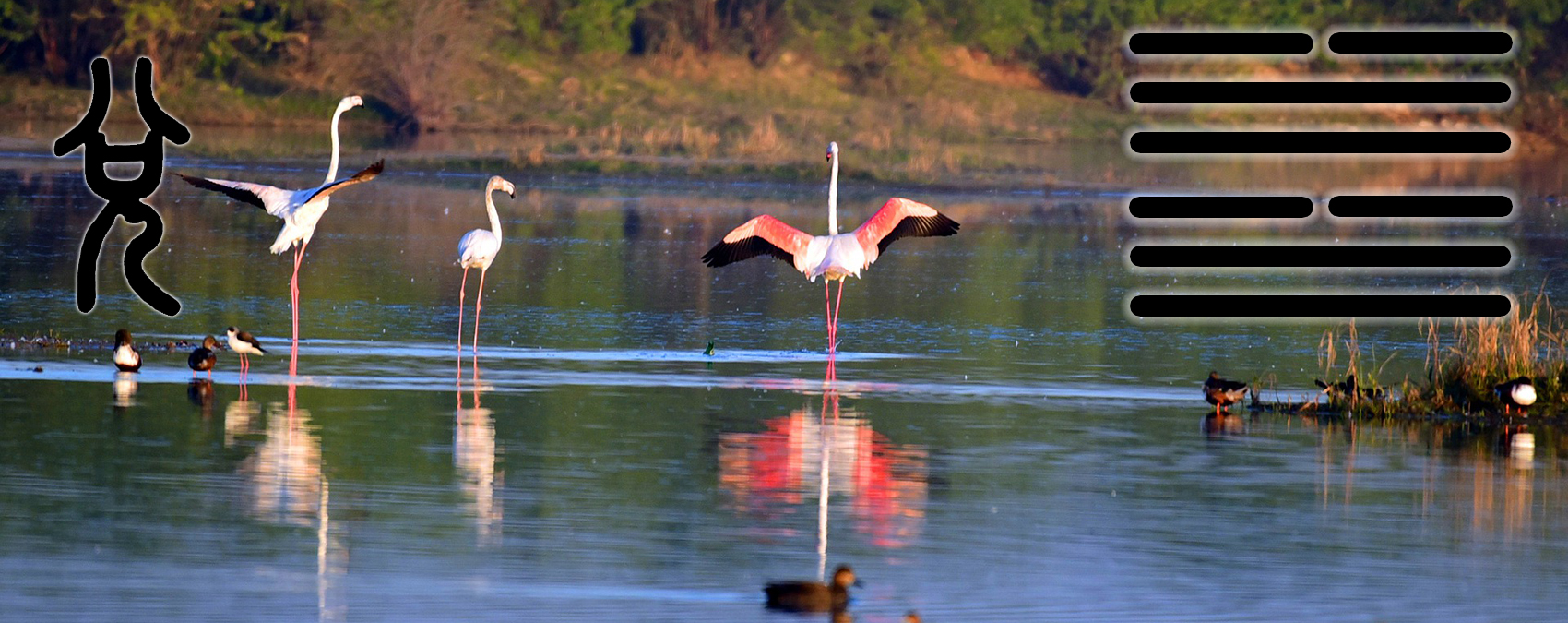Lake above – Lake below
The Chinese name of this hexagram is Dui which translates to joy, pleasure, happiness, exchange, share, open up. Dui is associated as the root of the Chinese character “speaking”. Joy is a by-product of opening up to others to connect, share and exchange. The shape of this 3-line trigram is interesting. Trigram Lake shows 2 solid lines inside on the bottom with an opening (broken line) on top, symbolizing an opening up to interaction and exchange. The ancient Chinese is notable as they did not have roofs on their shrines so there would be opportunities for open communication with the higher realms. Other titles of this hexagram are: Opening, Satisfaction, Delight.
Breaking down the symbolism of the 3-line trigrams helps with understanding the ancient teachings:

When trigram Lake is below (the bottom 3 lines in image below right), it references the inner realm of the person or situation. Trigram Lake is then doubled and becomes the external realm as well (top 3 lines of image below right). When lakes join they are in less danger of drying up because they have each other as a source of replenishment. It is this image that conveys the refreshing revitalization that interchange between people can bring. Knowledge and wisdom shared between people, based on their practical experience, is often more illuminating than trying to learn on one’s own. The lower 2 solid lines of trigram Lake show internal firmness of character (which holds one’s individual truth) and the broken upper line shows the gentleness and flexibility needed to respond to others.
The ancient ideograph is on the upper left portion of the image below. The middle portion is an ideograph of a mouth with legs dancing below and arms swinging joyfully above. This shows a person expressing happiness in a dance.

In summary: In China the rice paddies are marshes. Marsh is another name for trigram Lake and came to represent places to celebrate when rice (a staple food) was in abundance. Water symbolizes the emotional realm and Lake/Marsh shows a place where joyful, emotional exchanges can take place. As long as one resists self-indulgence by merely passing the time or seeking comfort, these exchanges can develop into the sharing of information and skills as well. The hexagram lines themselves suggest success lies in holding firm with integrity internally while outwardly gentle and joyful.
Following are a few ideas for interpretations of each line:
Line 1 – At the beginning of Joy, you are in a good place where there is a sense of self-sufficiency and inward harmony. This quiet, certain joy of this type of contentment is essential to true freedom.
Line 2 – You have the ability to stay with your inner truth and sincerity; by doing so there will be success. If a loss of faith tempts you following another’s opinion, this would be cause for regret.
Line 3 – Real joy does not depend on outer circumstances being a certain way. By trying to force what you think you want into being, you may miss the Joy that exists right now in your life. Look carefully to see if you have a lack of control or unrealistic outlook.
Line 4 – Analyzing, judging, measuring what would give you joy can lead to deconstruction of the ability to experience joy. Joy is individual; you can have points of disagreement with others and still enjoy their company. Remember that true joy can be found even in the midst of personal limitations.
Line 5 – The vulnerability of your position lies in misplaced trust in other people, situations, your own feelings or thoughts which seek to bring you down. Remain vigilant against negativity as well as your own current tendency toward fascination with illusions.
Line 6 – It is easy to get caught up in the “search for joy” whereby it becomes the focus of your life. When this happens, it is easier to mistake other’s opinions for your own and/or get caught up in self-indulgence or vanity. True joy comes from internal strength and sincerity.
